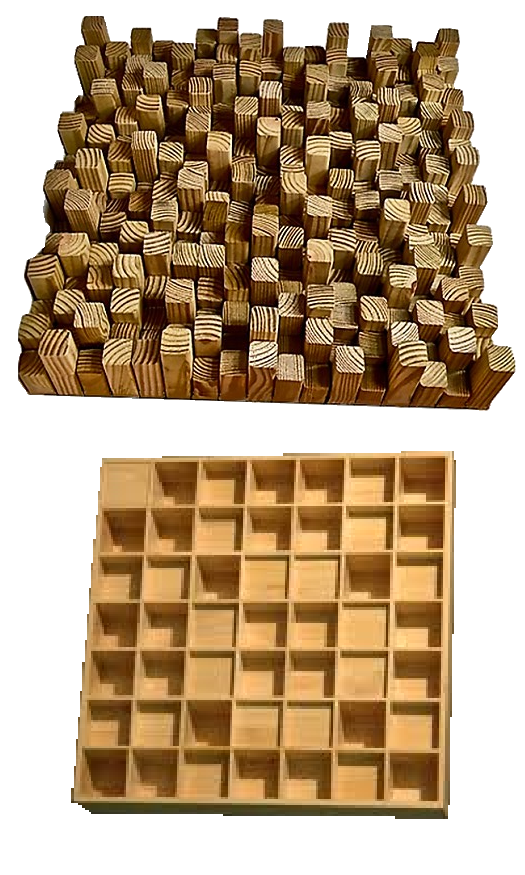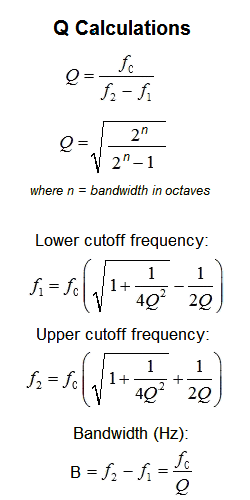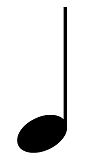——— Q ———
Q – see quality factor.
Q8 – see Quad-8.
QAM – Quadrature Amplitude Modulation. See C-QUAM.
QEO effect – Quadratic Electro-Optic effect. See Kerr effect.
Q factor – see quality factor.
QoS – Quality of Service.
QPPM – Quasi Peak Program Meter. See peak program meter.
QRD® – a registered trademark of RPG Diffusor Systems, Inc. for a quadratic-residue diffuser, first introduced commercially in 1983. QRD is often used as a generic abbreviation for the quadratic-residue diffuser.
QS – a quadraphonic vinyl record format that used a type of matrix encoding and decoding, marketed by Sansui Electric beginning in 1971. Also called Command Quadraphonic. See also Quadradisc and SQ.
quad – (1) Short for quadraphonic. (2) Short for quadruplex video recorder.
Quad-8 – RCA's trade name for their quadraphonic (4-channel), eight-track tape cartridges, now defunct. It began as Quadraphonic 8-Track, and was later shorted to Quad-8, and eventually just Q8.
Quadradisc – a discrete 4-channel vinyl record introduced by JVC in 1971. Although this was the only commercially successful discrete quadraphonic record, it was rather short lived. Also called CD-4 (Compatible Discrete 4). See also SQ and QS.

(Schroeder Diffusers)
quadratic-residue diffusor (QRD) – a diffuser composed of a large number of wells of various depths, designed so that sound waves striking them bounce out of each well at slightly different times, thus diffusing the sound. Also called a Schroeder diffusor, named for Manfred R. Schroeder, its inventor or a “skyline” diffusor, because the blocks resemble a city skyline.
quadraphonic – a now defunct audio format consisting of four channels, two in front and two in the rear. Although its configuration was different from modern surround sound, it was the first attempt at a surround sound system. Its commercial failure was due in large part to the numerous competing and incompatible formats for producing quadraphonic sound, as well as the increased hardware expense compared to regular stereo. Sometimes called quadrasonic or quad for short.
Quadraphonic 8-Track – see Quad-8.
quadrasonic – see quadraphonic.
quadrature – the state of having two signals that are 90 degrees out-of-phase with each other.
quadrature scanning – a type of videotape scanning in which the head scans across the tape, as opposed to helical scanning.
quadruplex videotape – a professional 2-inch analog magnetic tape format for video developed by Ampex and released for the broadcast television industry in 1956. It was the first practical and commercially successful recording videotape format. It was developed for use in a quadruplex videotape recorder (VTR), which was released the same year. Prior to this, the only method for recording video was film-based kinescopes, which were more expensive, required time-consuming processing to develop the film, and produced poor-quality images. Also called 2-inch quad, 2" quad, or quad for short. See also type B videotape and type C videotape.
quadruplex videotape recorder – the first commercially successful analog quad tracking videotape format, developed in 1956 by Ampex. A quadruplex videotape recorder (VTR) has four magnetic heads mounted on a headwheel spinning transversely (width-wise) across the recording tape, with a tape speed of 7½ ips (19.05 cm/sec) or 15 ips (38.10 cm/sec) for NTSC video. This method was called quadrature scanning as opposed to helical scanning formats, which eventually replaced it. Called quad for short.
quad tracking – (1) Recording a performance in four separate takes, similar to double tracking. This techniques is most commonly used for tracking guitars, placing two takes on the right and two takes on the left. (2) Another term for quadrature scanning.

quality factor (Q) – a dimensionless parameter that designates the sharpness of a peak, most often used in reference to filters and equalizers, but it can be used to describe characteristics in other components, electronic circuits, and speakers. In equalizer circuits, Q is defined as the center frequency divided by the half power bandwidth. (See equations below.) In loudspeakers and microphones, the quality factor is used to designate the directivity (a measure of the directional characteristics). See directivity. Sometimes called resonance. Called Q or Q factor for short.
quality of service (QoS) – the assessment or measurement of overall performance of a service, especially in telecommunications and computer networks. In particular, it is the observed performance obtained by the users of the network.
quantization – (1) The conversion of an analog wave into very small discrete steps prior to digitization. (2) The correction of rhythms in a MIDI sequence or audio signal, such as drum hits that are not quite on the beat. British spelling quantisation.

quantization distortion – see quantization error.
quantization error – the difference between the original wave and its representation after quantization. This can be a source of quantization distortion, also known as granulation noise.
quantization level – the discrete value for a particular point of an analog signal which is being quantized. Also called a quantizing level.
quantization noise – a type of error introduced into an analog audio signal by encoding it in digital form.
quantize – (1) To convert an analog signal or wave into very small discrete steps prior to digitization. (2) To correct the the rhythms in a MIDI sequence or audio signal. This process is used to correct timing errors, but over-use can remove the human feel from a performance. British spelling quantise.
quantizing increment – (1) A step between each sample during analog-to-digital conversion. For example, at a bit depth of 16, there will be 65,536 quantizing increments. (2) The amount of voltage or decibel value that each quantizing step represents. At 16 bits, there are 65,536 steps. To represent a signal voltage from 0.0 V to 1.0 V, each quantizing increment will correspond to 1/65536 V or about 0.000015 V.
quantizing level – see quantization level.
quantum microphone – a new technology that can detect sound at the quantum mechanics level developed by scientists at Chalmers University of Technology in Sweden. It is based on a circuit using a single-electron transistor (SET), a transistor that passes one electron at a time.

quarter note – a music note having one-fourth the time value of a whole note. In 4/4 time, the quarter-note is equal to one beat. Also called a crotchet (mainly British).
quarter rest – a rest that has the same length as a quarter note.
quarter space – the sound environment created when a loudspeaker is placed at a junction between two walls, such as in the corner of a room. This situation yields an additional 6 dB of sound power level, especially in the bass frequencies, compared to a speaker in a free field. See also half space and ⅛ space.
quarter tone – (1) Half a semitone or one-fourth of a whole tone. (2) A system of music that has 24 tones per octave with each tone being one-fourth of a whole tone, often used in Eastern music.
quarter-tone bend – a guitar technique, sometimes used in blues, rock, country, and other music genres, in which a string is stretched (bent or curled) producing a tone that is a quarter tone higher in pitch than the original unbent fretted note. Also called a blues curl or microtonal bend.
quarter track – see 4-track.
quarter-wavelength null – see ¼-wavelength null.
quartz crystal – a small piece of quartz cut along certain planes and ground so that it will can produce vibrations of a constant frequency to be used in crystal oscillators and other applications.
quasi-balanced line – see pseudo-balanced line.
quasi-parametric equalizer – an equalizer that provides for control of frequency and gain on each band of equalization, but not bandwidth. Also known as a semi-parametric. See also parametric equalizer.
quasi peak program meter – see true peak meter or peak program meter.
QuickTime – a multimedia format developed by Apple for handling various formats of digital video, still images, sound, panoramic images, and interactivity. QuickTime files can combine sound, text, animation, and video in a single file that can be viewed using a QuickTime player that can be downloaded from the internet and often included with a Web browser. QuickTime files use file extensions of .qt, .mov, or .moov and is is compatible with both Macintosh and Windows platforms.
quiescent current – see standby current.
quiescent noise – the amount of noise in an empty recording or listening space. It consists of all sources of sound, such as traffic noise, HVAC equipment, fluorescent light hum, computer fans, and loudspeaker hum. Sometimes erroneously used interchangeably with noise floor.
QRD – Quadratic-Residue Diffuser.
.qt – one of the file extensions for the QuickTime format.
Note: We believe this is the largest dictionary (glossary) of terms specific to usage within the recording industry that is currently available on the internet, with more than 8,800 entries, nearly 800 illustrations, and dozens of tables. Some of the terms have different or additional meanings in other situations, especially within the electronic, automotive, scientific, and computer industries. Of necessity there are obvious overlaps into other fields such as music, electronics, and computers, but such excursions are limited to information deemed pertinent to the knowledge required to operate and/or participate effectively in the workings of a recording studio. Also included are terms related to sound reinforcement (live performances) including wireless microphone technology because a working knowledge of that terminology is necessary for recording at live performance venues. Because recording studios also record audio for video and motion pictures (films), some terminology from those fields is included. Some scientific terms are included because they help explain studio terminology. For example, electromagnetism explains how microphones, loudspeakers, and guitar pickups work. Knowledge of radio waves and the radio frequency spectrum is needed to explain wireless devices. Any trademarks or trade names mentioned belong to their respective owners. The information contained in this dictionary is believed to be accurate at the time of publication. This information is subject to change without notice. The information was obtained from and cross-checked with a variety of sources that are believed to be reliable. However, Los Senderos Studio, LLC does not guarantee the accuracy or completeness of the information contained herein. Please contact us to report any errors, omissions, discrepancies, or broken links. Los Senderos Studio shall not be responsible for any consequences or damages arising out of the use of this information. Nothing in this glossary should be interpreted as legal advice. For a glossary providing information on legal and business matters for musicians, we suggest you consult Musicians Business Dictionary.
A note on alphabetical order: The terms in this glossary are alphabetical without regard to spaces and punctuation. For example, AM Radio follows amplitude. While this may seem to be at odds with other conventions, it eliminates confusion with words such as pickup, which is sometimes written as pick up or pick-up. In addition, all symbols such as &, -, or / are ignored. The entries on the number page (0-9) are listed in increasing value within each digit. For example, all of the entries beginning with 1 are listed before those starting with 2. For Greek letters (α-ω), the entries are in Greek alphabetical order.


